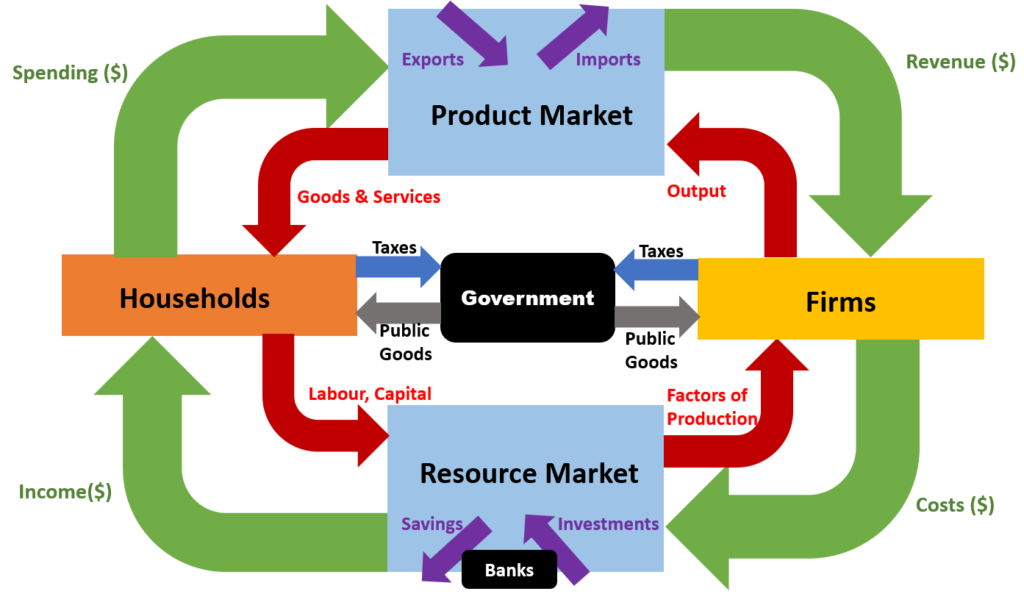Circular Flow of Money
The Circular Flow Model

The circular flow model can help us visualize the interactions between households, firms, and the government. The above diagram is a circular flow model depicting an open economy, that is with imports and exports included. We need to “follow the money” to understand these interactions between the various parties.
#1 The Interactions Between Households & Firms
- In this section, we shall focus on the relationship and interactions between “households” and “firms”. “Households” simply refers to workers like you and me. We offer our labour to “firms”, the companies we work for.
- Firms need labour to run in order to produce goods and services. On the other hand, households need income to buy these goods and services to survive.
- Let’s start with households. The households work to earn wage income. This “work” or labour resource provided is a factor of production. The firms then pay households wages in exchange for their labour resource. Now, the households have money to spend.
- The households then use some of this money to buy goods and services in the market to consume. The payment for goods and services are actually revenue streams going to firms. Now, the firms have money to pay.
- What do the firms need to pay? They need to pay for the “factors of production”, such as labour and capital. These are actually costs that firms need to incur in order to continue operation.
- Hence, we can see money flowing from firms to households, and then from households back to firms. This money flow is shown as green arrows in the diagram. There is also another flow, labour-goods flow as shown by the red arrows, going in the reverse direction from households to firms and then from firms back to households.
- These circular interactions between firms and households are the essentially life-force that keeps the economy going.
#2 The Interactions Between Government and Others
- Aside from firms and households, there is another entity called government. Let’s now understand how government interacts with firms and households.
- Government collects taxes from both households and firms. These taxes are actually money going to the government. Hence, now the government has money to spend.
- What does government spend on? They spend on building public goods, such as physical infrastructure (like roads, bridges, seaports, and airports), and the soft infrastructure (like law and order, education, and more).
- Both households and firms benefit from consuming these public goods. For instance, households benefit from the law and order provided by the government to keep their lives safe. On the other hand, firms can benefit from the efficient transportation infrastructure as they can deliver goods more efficiently to their customers.
#3 Leakages and Injections 1: Savings vs Investments
- Although households earn wages to spend on their consumption, they may not spend all their wage income. A fraction of this wage income is saved.
- However, income that does not circulate in the economy is a leakage. Hence, savings are leakages in the circular flow model.
- Let’s assume that households place their savings in banks. So now the banks have money, and they can lend these out to firms for investments.
- When firms invest, they are putting money back to the system. Hence, investments are injections in the circular flow model.
- In order words, there are money leaking out of the system, and money being injected back into the system.
#4 Leakages and Injections 2: Imports vs Exports
- Let’s talk about another form of leakage and injection. This comes from the import-export sector.
- Households have freedom to select the type of goods and services to buy. They can consume goods and services that are locally made, or made in other countries. When households buy foreign goods, that is an imported good such as a book. Money actually flows out of the system to another country. Since the money is no longer circulating in the economy, it is therefore a leakage.
- On the other hand, domestic goods can also be exported out to foreign countries. When foreigners buy our goods and services, money comes into the system. This is a form of injection.
- In summary, imports are leakages, while exports are injections.
